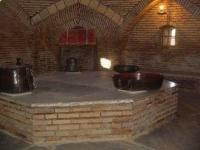You are here
Bukhara baths.

Photo tours of Samarkand mosques.
"What a woodcutter, what a bathers, is"
Natural Wonders of Bukhara.
Next to the passage, Tak-i Sarrafon - restored after archeological excavations Sarrafon is an indispensable component of the urban community center. Medical and hygienic properties of the bath attached great importance.
Even in the “Canon of Medicine”, Abu Ali ibn Sino notes the dignity of a good bath with a solid structure, moderate temperature, bright light, good air, a spacious dressing room painted with beautiful pictures, pleasant water.
The entrance to the bathhouse Sarrofon leads directly from the street to a relatively spacious changing room and a resting place. Then begins a series of domed rooms buried in the ground, connected by narrow arched passages.
In Bukhara, another ancient bath, the Bozor-i Kord, was preserved, next to the Tak-Telpak Furushon dome. The basements of the ancient baths squeezed in among the market buildings and barely rise above the street with their inexpressive low domes.
Bukhara baths are of historical and cultural interest, as typical monuments of civil engineering of Bukhara of the XVI century. Baths are often confused with special rooms for ritual ablutions - they were in many quarters of the city and were of two types.
Tahoratkhona - a place for incomplete ablutions, which, according to sharia, must precede each prayer, iguslhona - rooms divided into isolated booths where complete ablutions. The latter were encased in water all over the body - from head to toe - and were required after marital intimacy.
Such ablutions were also performed at home, but in the cold winter time there was warm water, which ensured a high level of comfort for the pampered residents of the capital. In Guslkhona, all who needed to use them were in a robe thrown over their heads, as they had been considered unclean before bathing.
The maintenance of the premises for washing was the responsibility of the parishioners themselves. For this, either each family delivered fuel for it, or all residents of the quarter participated in its purchase. The quarterly community hired some poor man from among the residents of the quarter who served the ablution room and heated the water.
Enlightener:
VG Saakov "History of Bukhara". Shark Publishing House, 1996. “Bukhara. Masterpieces of Central Asia. Historical guide to Bukhara. year 2012. "Bukhoro Bukhara Bukhara" In Uzbek, English and Russian. Publishing House "Uzbekistan", Tashkent 2000. Muhammad Narshahi. History of Bukhara. Tashkent. 1897 (translated by N. Lykoshin). V.G. Saakov Architectural masterpieces of Bukhara. Bukhara regional society "Kitabhon" Uz SSR, Rovno 1991, Robert Almeyev. The history of ancient Bukhara. (Edited by Academician of the Academy of Sciences of the Republic of Uzbekistan Rtveladze E.V.)
Photos by
Alexander Petrov.







